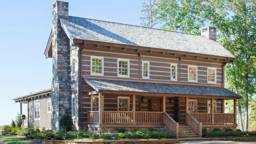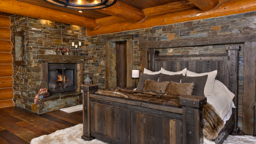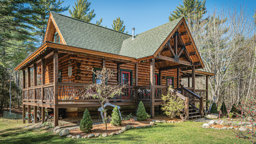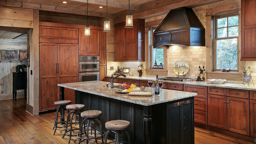by: Tracy M. Ruff What can you learn from visiting a model log home? This may sound like a simple question at first. But during my visits to three area model houses, I discovered that the real question is, "What can't you learn?"
The Approach
Let me start by explaining how I selected the models I visited: I opened an issue of Log Home Living, flipped to the Builder-Dealer Marketplace toward the back of the magazine and made some phone calls. Pretty easy! The criteria were that the model had to be within 1 1/2 hours driving time and that the representatives could meet me during the workweek. I also wanted to see a variety of log homes and building systems; some newly built, some older. But where do you begin? Terry and Sandi Shriner,
Fairfield, Pennsylvania, representatives for Wilderness Log Homes, offered some beginner's advice. "You have to take it one step at a time, or you're going to drive yourself crazy," Sandi says.
Packages Unwrapped
Upon entering the models, it was apparent that they were all very different. The Shriners' model home has round logs on the exterior, which I would later find out were actually half logs. Square logs form the other two homes, both in Virginia—one by Heritage Log Homes in Unionville and the other by Kuhns Bros. Log Homes in Culpeper. That prompted me to wonder, "What exactly is included in a log home package?" The representatives clarified my confusion with an answer that may sound more confusing: Not all log home packages are the same. You have to know what is included and what is not included in the package to come up with an accurate price. Does the package include only the logs and erection? Will the log home package include windows and doors? How about flooring and cabinets? What about the roof? "People will come in with numbers all over the map," says Bill Miller, builder-dealer for
Kuhns Bros. Log Homes. "We have to explain the different variables and get the details." His business partner Bob Russell agrees that folks need to compare similar package contents, or "apples to apples," when dealing with different companies' log package prices. From the representatives, I learned what each company offered in its log home packages. They explained the
species of logs used,
corner styles available and log styles offered. Along with the materials used for their own homes, the representatives had samples of the selections offered by their respective companies. The representatives were also very helpful in discussing, in layman's terms, the types of sealant systems that are used for their houses.
Shattered Myths
I found it interesting that a lot of what the representatives discuss in their initial meeting with clients are the myths associated with log homes. Just by stepping inside of these models, it was apparent that they did not have to explain that not all log homes are dark inside. By the use of windows and the siting of their homes, the interiors are light and airy. Also, the types of stains used on the inside walls brighten the interiors. It's interesting that none of the models I visited used drywall for interior walls. Another misconception that representatives discuss with potential clients is regarding log settlement. Some folks are horrified by the idea that the log walls will move, or settle, as they dry out. Bill tells his clients that settlement is a natural occurrence, and that if the home is built well, it's not an issue. He also explains that
Kuhns Bros. kiln-dries their logs to alleviate the effects of shrinkage. For Sandi and Terry, settlement is not even considered a factor since Wilderness Log Homes' houses are not full-log, but half-log homes. Then, Betty and Rixey Almond, builder-dealers for
Heritage Log Homes, showed me the adjustable jacks in their home, which can easily be adjusted throughout the years to accommodate any settlement.
Design Options
Upon entering a model home, most clients have a pretty good idea of the design of their log home. Some people have selected a floorplan from a catalog, and others want a totally customized home. The log home representatives can help in any situation. The representatives all agree that there is no hurry to come up with the initial design. They take their time with the clients and get to know more about them. What is their lifestyle? Do they want to take advantage of views? Do they want a fireplace? Are they empty-nesters, or are they just starting a family? Representatives take these ideas and put them down on paper. Sandi and Terry work with clients in a three-phase design process before the plan is complete. On the other hand, Betty and Rixey find that 90 percent of their clients select standard Heritage floorplans and only slightly modify them. Design is an area where the representatives help clients "fit" into their dream homes. They will suggest design alternatives, such as resizing the master bedroom or leaving the basement unfinished, to help clients come within their budgets and not lose track of their initial dream log home. It was amazing to see how different the design of each of the models was from another. The Shriners' home features a loft with a very traditional feel. Bill Miller's home has a very open floorplan with a large expanse of windows. And most of the living area in the Almonds' place is on the first level. And the exteriors-all unique.
Dealer vs. Builder-Dealer
Once the clients have all of their questions answered and have purchased their log home, it's time to have the house built. But who is going to build it? Two of the representatives that I met with are what the industry calls builder-dealers. This designation means that along with selling the log home, a part of their company also can build the home. The Almonds and Bill and Bob offer building services along with their packages. The Shriners are authorized dealers and, at this time, do not offer building services. Yet they are able to recommend qualified builders in your area. All of the representatives will discuss the entire construction process with you, from building the foundation to delivering the logs to turning the key and walking into your new log home. But, they caution clients not to be overwhelmed with the process. "People tend to think of the building process from A to Z and think that it's a lot of work," Sandi says. "But we just tell them to take it one step at a time."
Expert Advice
All of these representatives have built their own log homes and made them their own. "This was our lifelong dream, and we know that a lot of other people want log homes," Sandi says. Gather ideas from them-either good or bad. Look inside and determine what you would incorporate into your home and what you would not. Does the furniture arrangement work nicely? Would you like a wood-burning or gas fireplace? Does the room flow make sense? These places are not only shown as models, they are family homes. So look beyond the decor and dirty dishes in the sink and make your decisions based on the representatives' knowledge of the product and their ability to communicate with you. They have been down the path that you are about to travel. Learn from their experiences.





_11868_2023-12-20_08-12-256x288.jpg)





